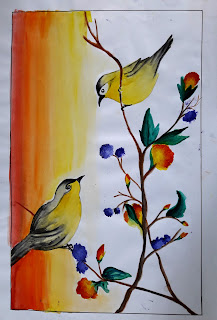COMPOSITION
- Drawing can be made in all mediums.
- Drawing board and pins.
- Drawing paper and canvas.
- Pencil color, oil pastel, crayon, and ink.
- Watercolor, poster color, acrylic colors, and oil colors.
- Collage (using colored papers or waste materials)
- Brush, palette, glue, and scissors.
|
Geometrical Composition |
|
Fig.1 |
•
The composition in which geometrical figures are used is called geometrical
composition. • Take plain paper. • Draw different shapes with a pencil. • Use a scale to perfect the shapes. •
Cut a square, triangle, or circle to make the shapes look interesting. • Colour the shapes. •
Colours and shapes should be balanced and look harmonious. |
|
Conceptual composition |
|
|
Fig.2 |
• Sometimes you can express a concept through painting instead of a story. •
Use forms and colors as symbols that are always not identifiable. • So, conceptual composition sometimes becomes abstract or non-representational. •
In this particular painting, the sun and the skeleton of fish with other motifs are used symbols. |
![]()
|
Composition with Object |
|
|
Fig.3 |
•
Select a few objects like a light lamp and box, flower and keep them on an even surface. •
Hang a curtain from behind for the background. •
Draw the objects with visual measurement
. •
Mark very lightly the darker areas. •
Arrange watercolors in a pallet and keep water containers and brushes ready. •
Apply color from light to dark. Leave paperwhite for highlight. |
|
Composition with Nature |
|
Fig.4 |
• Paint villages, cities, mountains, rivers, canals, sea, forests to draw nature-based composition. •
Normally, horizontal format is used in the nature-based composition. • Draw the desired scene. • Try to keep a center of focus. • Mark the dark and light areas with a pencil lightly. •
Colour from top to bottom, keeping the highlighted
area free from color. |
![]()
|
Decorative Composition |
|
|
Fig.5 |
•
Draw sketches of any natural object such as flowers,
leaves, trees, birds, squirrels, etc. •
Arrange them with each other in design form, giving them ornamental shapes. •
For a good composition apply color with the base concept of balance, rhythm, and harmony. |
|
How to Draw and Paint a Composition? |
|
Fig.1 |
STEP
- 1 • Draw any scene of your choice. •
Keep one focal point or center of attraction. •
The rest of the composition has been made in perspective keeping the boat almost
as the center of focus. • Mark the light, middle and
dark areas. •
Start coloring your composition from the top. |
|
Fig.2 Fig.3
|
STEP
- 2 •
You can use brushes of different sizes (both round and flat) according to your need. •
Broader area like sky can be done with a flat brush leaving the highlights. STEP - 3 •
Apply the middle tone before the first coat dries completely. •
You have to ensure the colors don’t spread. •
Apply the darkest
tone.
•
Finish the painting
with fine brush
work wherever necessary. |
![]()



















0 Comments